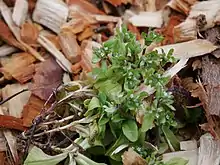Valerianella locusta
Valerianella locusta is a small annual plant that is eaten as a leaf vegetable. It has a characteristic nutty flavour, dark green colour, and soft texture, and is popularly served as salad greens.[2] Common names include corn salad,[3] common cornsalad,[4] lamb's lettuce,[3] mâche[3] (/mɑːʃ/), fetticus,[3] feldsalat,[3] nut lettuce,[3] field salad. In restaurants that feature French cooking, it may be called doucette or raiponce, as an alternative to mâche, by which it is best known.[5] In German-speaking Switzerland it is known as Nüsslisalat or Nüssler, terms that have been borrowed by the area's many English speakers.

| Valerianella locusta | |
|---|---|
 | |
| Corn salad is identifiable by its rounded leaf and deep green colour | |
| Scientific classification | |
| Kingdom: | Plantae |
| Clade: | Tracheophytes |
| Clade: | Angiosperms |
| Clade: | Eudicots |
| Clade: | Asterids |
| Order: | Dipsacales |
| Family: | Caprifoliaceae |
| Genus: | Valerianella |
| Species: | V. locusta |
| Binomial name | |
| Valerianella locusta (L.) Betcke | |
| Synonyms[1] | |

Description
Corn salad grows in a low rosette with spatulate leaves up to 15.2 cm long.[3] It is a hardy plant that grows to zone 5, and in mild climates it is grown as a winter green.
In warm conditions it tends to bolt to seed,[6] producing much-branched stems with clusters (cymes) of flowers. The flowers have a bluish-white corolla of five fused petals, 1.5 to 2 mm (0.06 to 0.08 in) long and wide, and three stamens. Underneath the flowers is a whorl of bracts. Fertilized flowers produce achenes with 2 sterile chambers and one fertile chamber.[7][8][9]

Distribution and habitat
Corn salad grows wild in parts of Europe, northern Africa and western Asia.[10] In Europe and Asia it is a common weed in cultivated land and waste spaces. In North America it has escaped cultivation and become naturalized on both the eastern and western seaboards.[11]
As a cultivated crop, it is a specialty of the region around Nantes, France, which is the primary producer of mâche in Europe.[12]

History
Corn salad was originally foraged by European peasants. Jean-Baptiste de La Quintinie, royal gardener of King Louis XIV, introduced it to kitchen gardening.[13] It has been eaten in Britain for centuries and appears in John Gerard's Herbal of 1597.[14] It was grown commercially in London from the late 18th or early 19th century and appeared on markets as a winter vegetable, but it only became available in modern supermarkets there in the 1980s.[15] American president Thomas Jefferson cultivated mâche at his home, Monticello, in Virginia in the early 1800s.[12]
The common name corn salad refers to the fact that it often grows as a weed in cornfields,[14] ("corn" is used in the sense of "cereal", not the US meaning of maize).

Nutrition
Like other formerly foraged greens, corn salad has many nutrients, including three times as much vitamin C as lettuce, beta-carotene, B6, iron, and potassium. It is best if gathered before flowers appear.[16]
| Nutritional value per 100 g (3.5 oz) | |
|---|---|
3.6 g | |
0.4 g | |
2 g | |
| Minerals | Quantity %DV† |
| Potassium | 10% 459 mg |
| Sodium | 0% 4 mg |
| |
| †Percentages are roughly approximated using US recommendations for adults. Source: | |
| Wikimedia Commons has media related to Valerianella locusta. |
| Wikispecies has information related to Valerianella locusta. |
References
- "The Plant List".
- "Valerianella locusta". Missouri Botanical Garden.
- "Valerianella locusta". Floridata.
- "BSBI List 2007". Botanical Society of Britain and Ireland. Archived from the original (xls) on 2014-10-23. Retrieved 2014-10-17.
- "Mâche". Larousse Cuisine.
- Plants for a Future: Valerianella locusta
- "Valerianella locusta". E-Flora BC: Electronic Atlas of the Flora of British Columbia.
- "Taxon Profile: Valerianella locusta". Flora of New Zealand. Missing or empty
|url=(help) - "Taxon Profile: Valerianella". Flora of New Zealand.
- "Valerianella locusta". Germplasm Resources Information Network (GRIN). Agricultural Research Service (ARS), United States Department of Agriculture (USDA). Retrieved 2017-12-18.
- "Valerianella locusta". Natural Resources Conservation Service PLANTS Database. USDA.
- "History of Mâche". Epicroots.
- Organic Gardening Magazine, August–September 2007
- Ayto, John, ed. (2002). An A-Z of Food and Drink. Oxford University Press.
- T. W. Sanders (1917), Vegetables and Their Cultivation, London: W. H. & L. Collingridge Limited
- Bender, David A., ed. (2005). Dictionary of Food and Nutrition. Oxford University Press.
Sources
![]() This article incorporates text from a publication now in the public domain: Ward, Artemas (1911). "[no title cited]". The Grocer's Encyclopedia.
This article incorporates text from a publication now in the public domain: Ward, Artemas (1911). "[no title cited]". The Grocer's Encyclopedia.